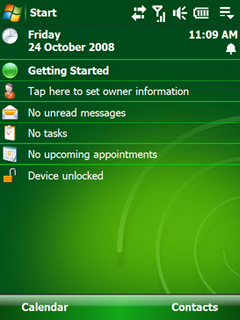Java Platform, Micro Edition or Java ME is a computing platform for development and deployment of portable code for embedded and mobile devices. Java ME was formerly known as Java 2 Platform, Micro Edition or J2ME.

A Pocket PC is a class of personal digital assistant (PDA) that runs the Windows Mobile or Windows Embedded Compact operating system that has some of the abilities of modern desktop PCs. The name was introduced by Microsoft in 2000 as a rebranding of the Palm-size PC category. Some of these devices also had integrated phone and data capabilities, which were called Pocket PC Phone Edition. Windows "Smartphone" is another Windows CE based platform for non-touch flip phones or dumber phones.
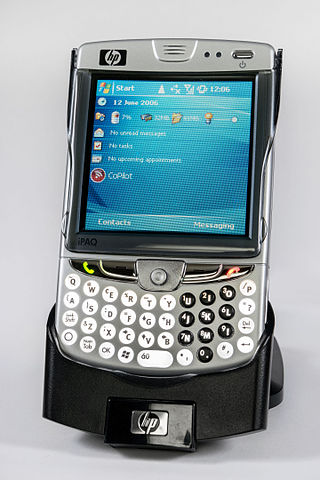
The iPAQ is a discontinued Pocket PC and personal digital assistant which was first unveiled by Compaq in April 2000.
Windows Embedded Compact, formerly Windows Embedded CE, Windows Powered and Windows CE, is a discontinued operating system developed by Microsoft for mobile and embedded devices. It was part of the Windows Embedded family and served as the foundation of several classes of devices including the Handheld PC, Pocket PC, Auto PC, Windows Mobile, Windows Phone 7 and others.
Casio Cassiopeia was the brand name of a PDA manufactured by Casio. It used Windows CE as the Operating system. Casio was one of the first manufacturers of PDAs, developing at the beginning small pocket-sized computers with keyboards and grayscale displays and subsequently moving to smaller units in response to customer demand.

Windows Mobile is a discontinued mobile operating system developed by Microsoft for smartphones and personal digital assistants.

A handheld personal computer (PC), typically built around either a clamshell form factor or a gaming form factor with a gamepad integrated for video games, is a mobile device that is significantly smaller than any standard personal computer (PC), but based on the same principles as PCs. The clamshell form factor is sometimes referred to as a palmtop computer, not to be confused with Palmtop PC which was a name used mainly by Hewlett-Packard.

Internet Explorer Mobile was a mobile version of Internet Explorer developed by Microsoft, based on versions of the MSHTML (Trident) layout engine. IE Mobile comes loaded by default with Windows Phone and Windows CE. Later versions of Internet Explorer Mobile are based on the desktop version of Internet Explorer. Older versions however, called Pocket Internet Explorer, are not based on the same layout engine.
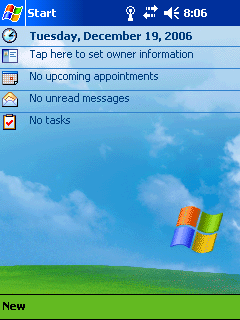
Windows Mobile 2003, originally codenamed "Ozone", was a member of the Windows Mobile family of mobile operating systems, released on June 23, 2003. It was the first Microsoft mobile OS to be called "Windows Mobile" and was based on Windows CE 4.20.
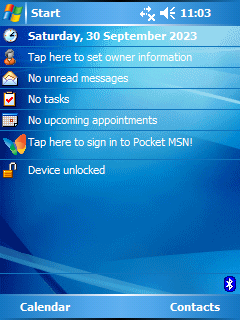
Windows Mobile 5.0, originally codenamed "Magneto", was released at Microsoft's Mobile and Embedded Developers Conference 2005 in Las Vegas, May 9–12, 2005. Microsoft offered mainstream support for Windows Mobile 5 through October 12, 2010, and extended support through October 13, 2015. It was first offered on the Dell Axim x51. It used the .NET Compact Framework 1.0 SP3, an environment for programs based on .NET. Windows Mobile 5.0 included Microsoft Exchange Server "push" functionality improvements that worked with Exchange 2003 SP2. The "push" functionality also required vendor/device support With AKU2 software upgrades all WM 5.0 devices supported DirectPush. This version featured increased battery life due to Persistent storage capability. Previously up to 50% of battery power was reserved just to maintain data in volatile RAM. This continued the trend of Windows-based devices moving from using RAM as their primary storage medium to the use of a combination of RAM and flash memory. Programs and frequently accessed data run in RAM, while most storage is in the flash memory. The OS seamlessly moves data between the two as needed. Everything is backed up in the flash memory, so unlike prior devices, WM5 devices lose no data if power is lost. New to 5.0, OS updates were released as Adaptation kit upgrades, with AKU 3.5 being the final released.

Microsoft Software Updater is a Windows and OS X based application launched in 2006, that enables customers to update and recover their mobile device firmware of a S40 or S60 or Lumia device from any Internet enabled access point. To avoid data loss users are prompted with on-screen advice on how to safely update their device.

Windows Mobile 6, formerly codenamed "Crossbow", is the version of Windows Mobile released on February 12, 2007 at the 3GSM World Congress 2007. It comes in three different versions: "Windows Mobile 6 Standard" for Smartphones, "Windows Mobile 6 Professional" for Pocket PCs with phone functionality, and "Windows Mobile 6 Classic" for Pocket PCs without cellular radios.

Jawbreaker is a port of SameGame for the Pocket PC bundled with the Microsoft Windows Mobile 2003 operating system for PDAs. The operating system, and thus the game, was officially released on April 7, 2003. The game itself was developed by American studio oopdreams software, Inc. Jawbreaker is officially listed as one of the "Core Applications" of the Windows Mobile software family, in a paper released by Microsoft. In Windows Mobile 5.0 and Windows Mobile 6.0 it is called Bubble Breaker. The original non-bundled version of the game is available from the developer itself as Bubblets.
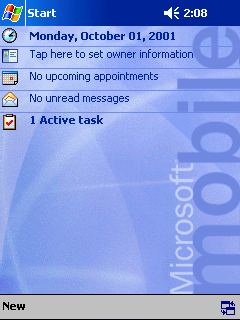
Pocket PC 2002, originally codenamed "Merlin", was a member of the Windows Mobile family of mobile operating systems, released on October 4, 2001. Like Pocket PC 2000, it was based on Windows CE 3.0.

Windows Mobile Device Center is a synchronization software program developed by Microsoft, and the successor to ActiveSync. It is designed to synchronize various content including music, video, contacts, calendar events, web browser favorites, and other files between Windows Mobile devices and the Microsoft Windows operating system.

Windows Mobile 6.5 was a stopgap update to Windows Mobile 6.1 intended to bridge the gap between version 6.1, that arrived in 2008, and Windows Phone 7 that was released in 2010.

Microsoft Lumia is a discontinued line of mobile devices that was originally designed and marketed by Nokia and later by Microsoft Mobile. Introduced in November 2011, the line was the result of a long-term partnership between Nokia and Microsoft—as such, Lumia smartphones run on Microsoft software, the Windows Phone operating system; and later the newer Windows 10 Mobile. The Lumia name is derived from the partitive plural form of the Finnish word lumi, meaning "snow".
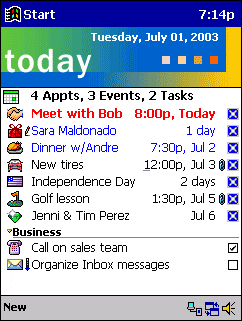
Pocket PC 2000 was the first member of the Windows Mobile family of mobile operating systems that was released on April 19, 2000, and was based on Windows CE 3.0. It is the successor to the operating system aboard Palm-size PCs. Backwards compatibility was retained with such Palm-size PC applications.
Pocket-sized computer describes the post-programmable calculator / pre-smartphone pocket-sized portable-office hardware devices that included the earlier DOS-based palmtops and subsequent Windows-CE handhelds, as well as a few other terms, primarily covering the 1980s through 2007.
